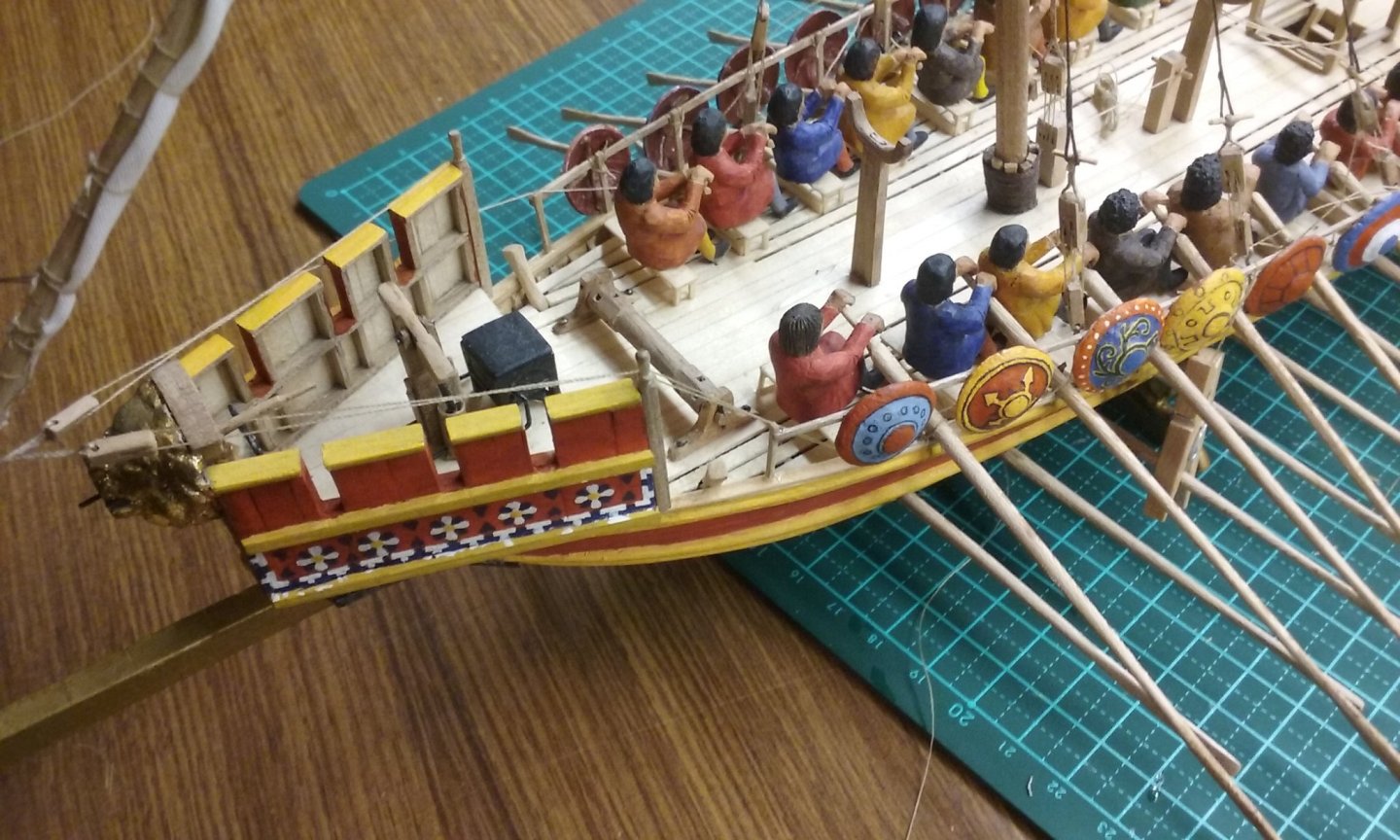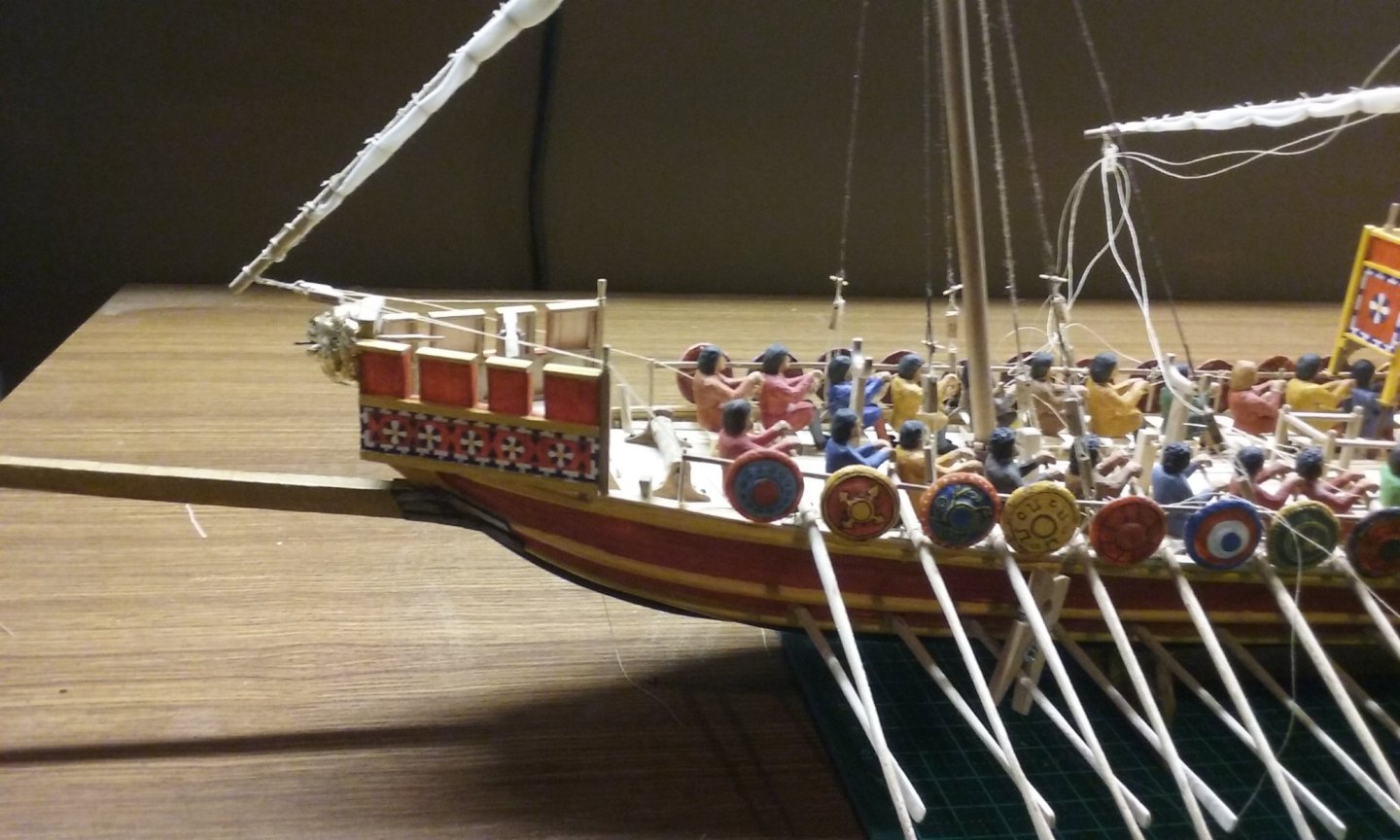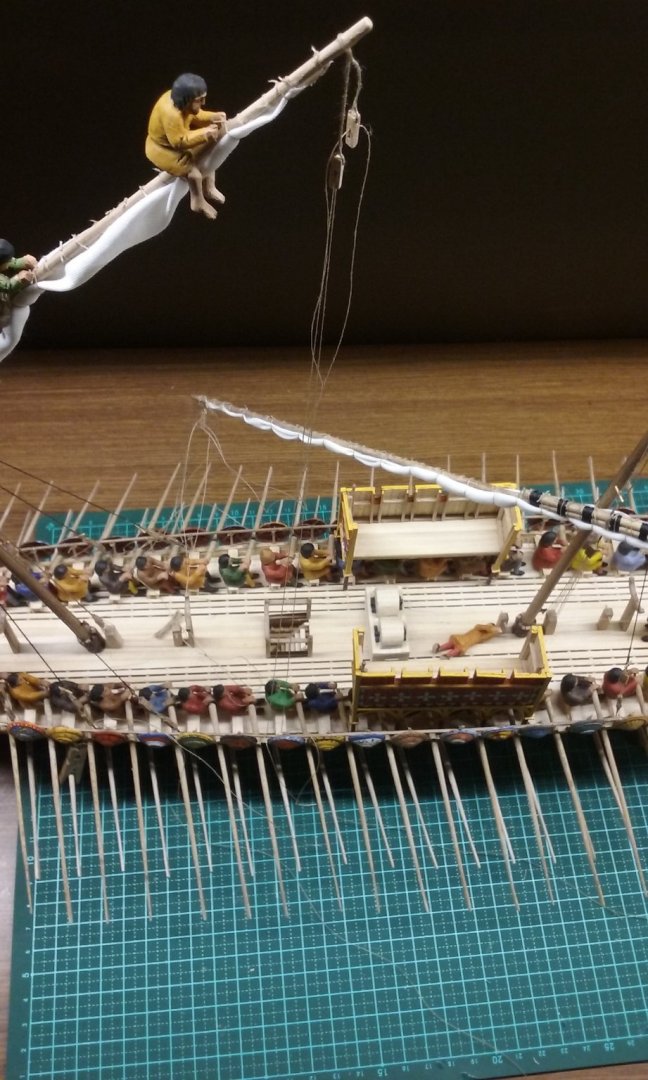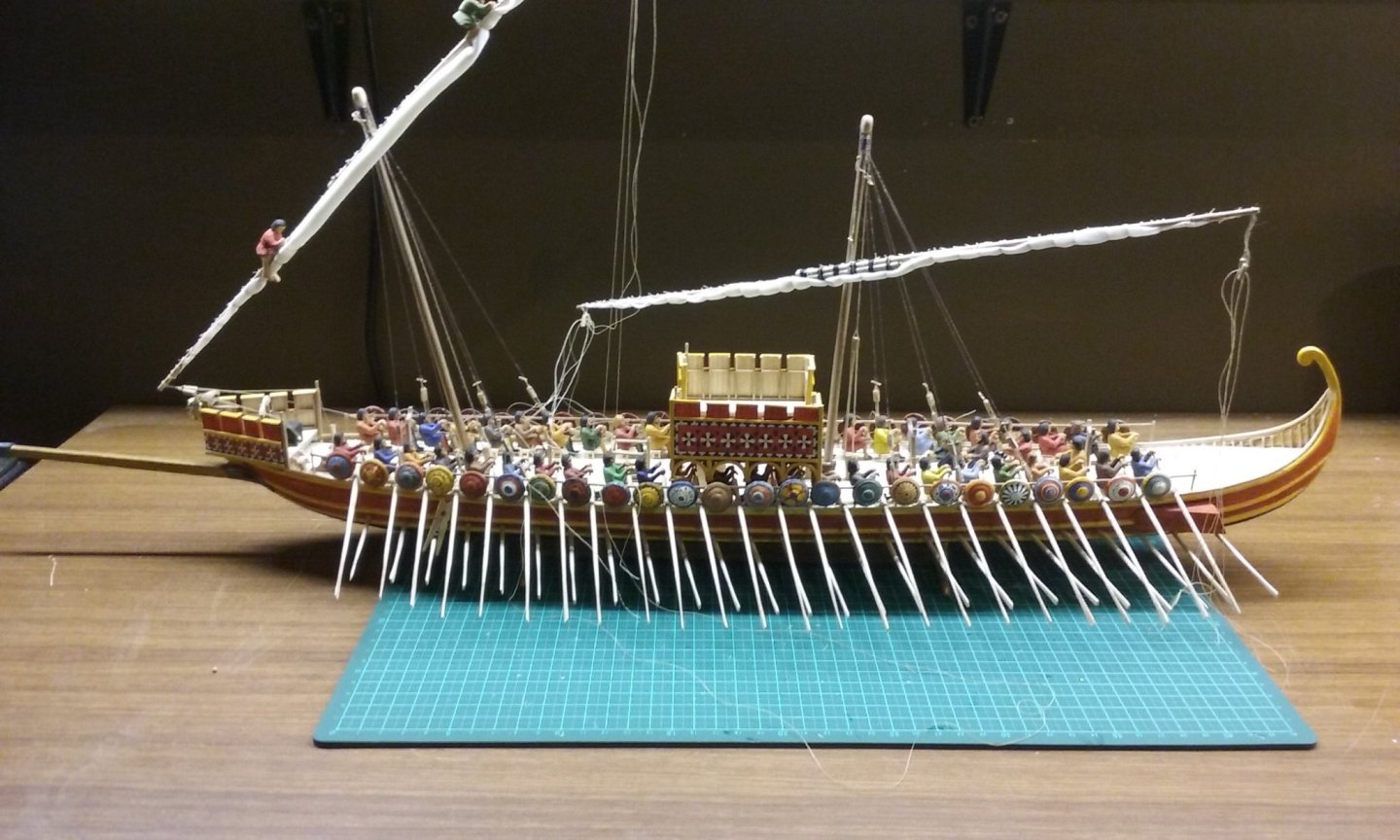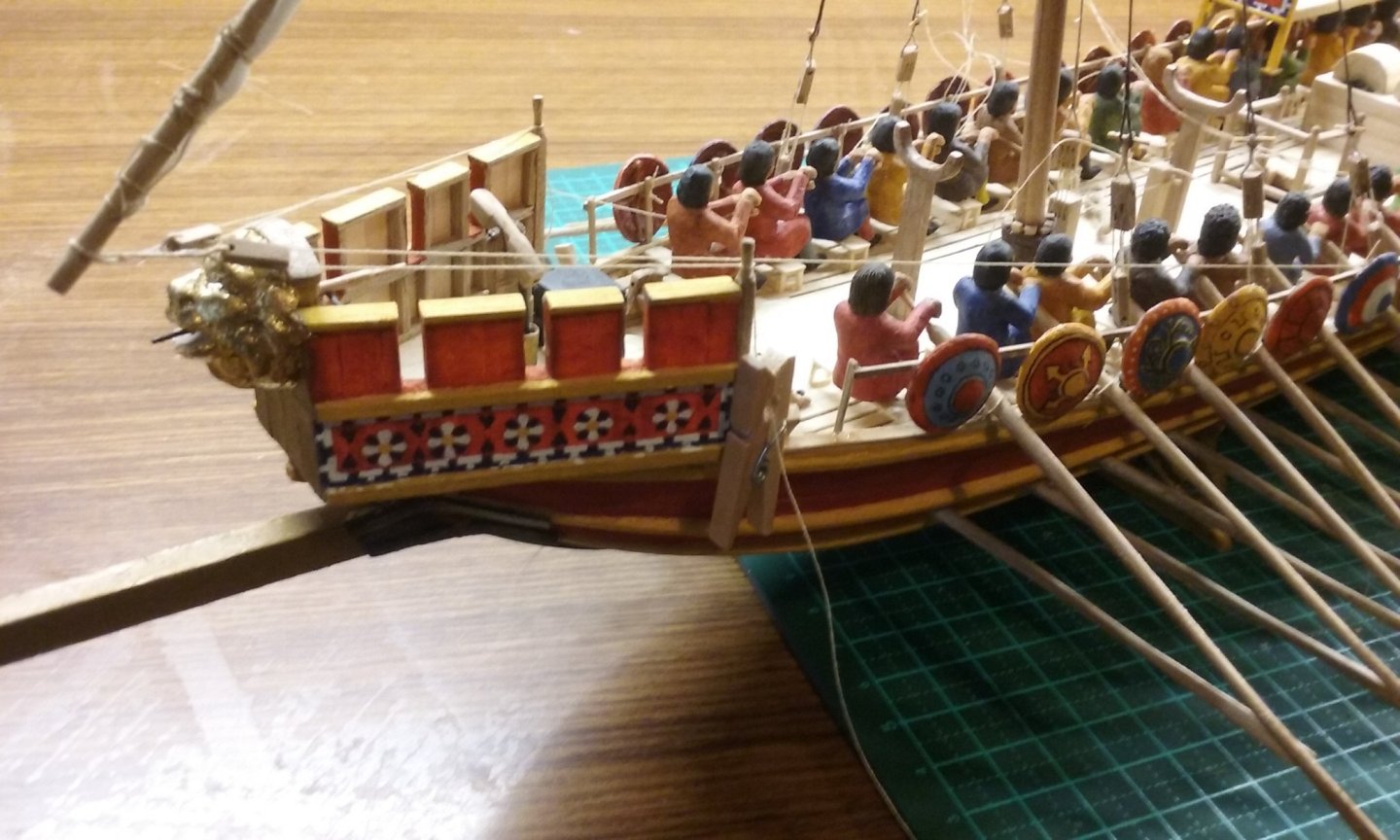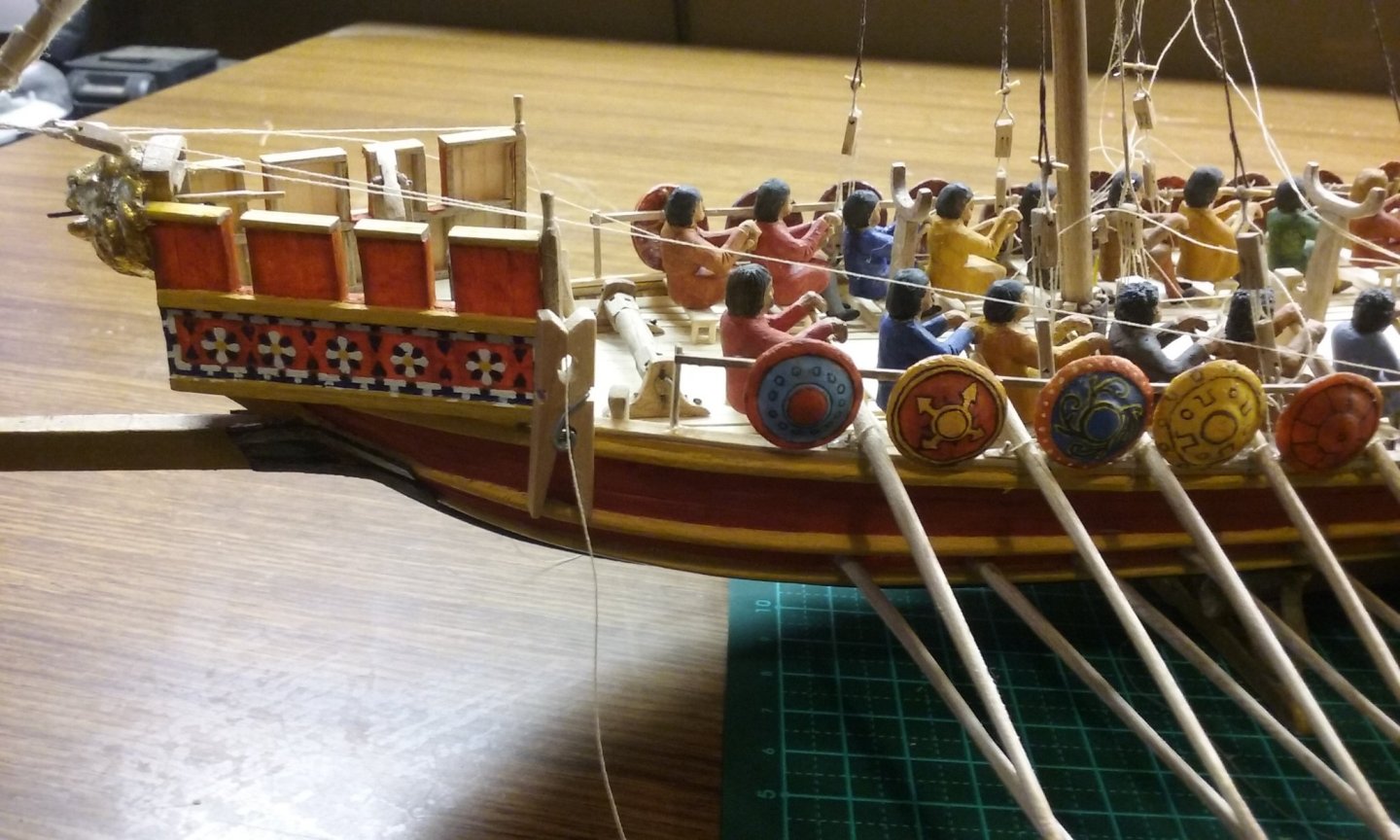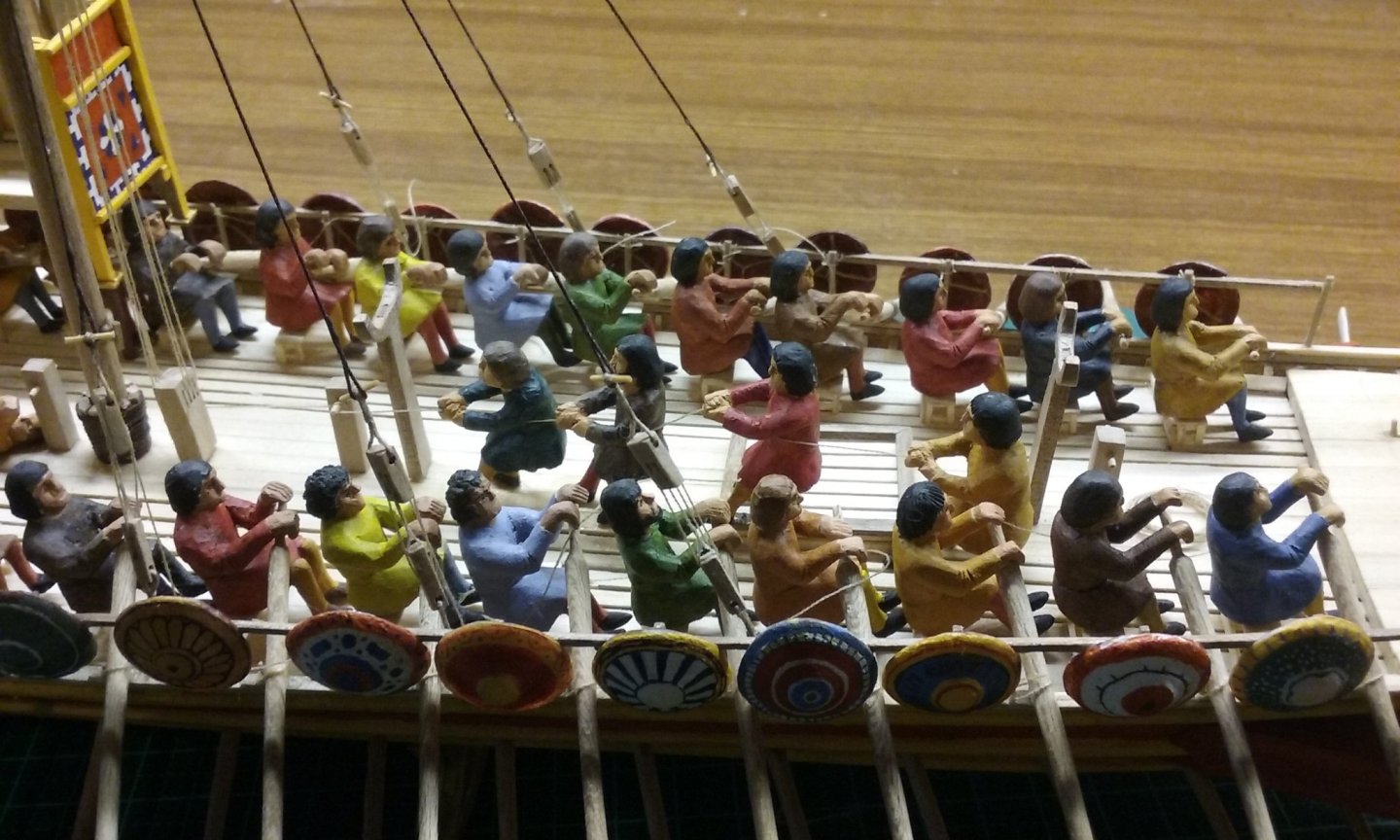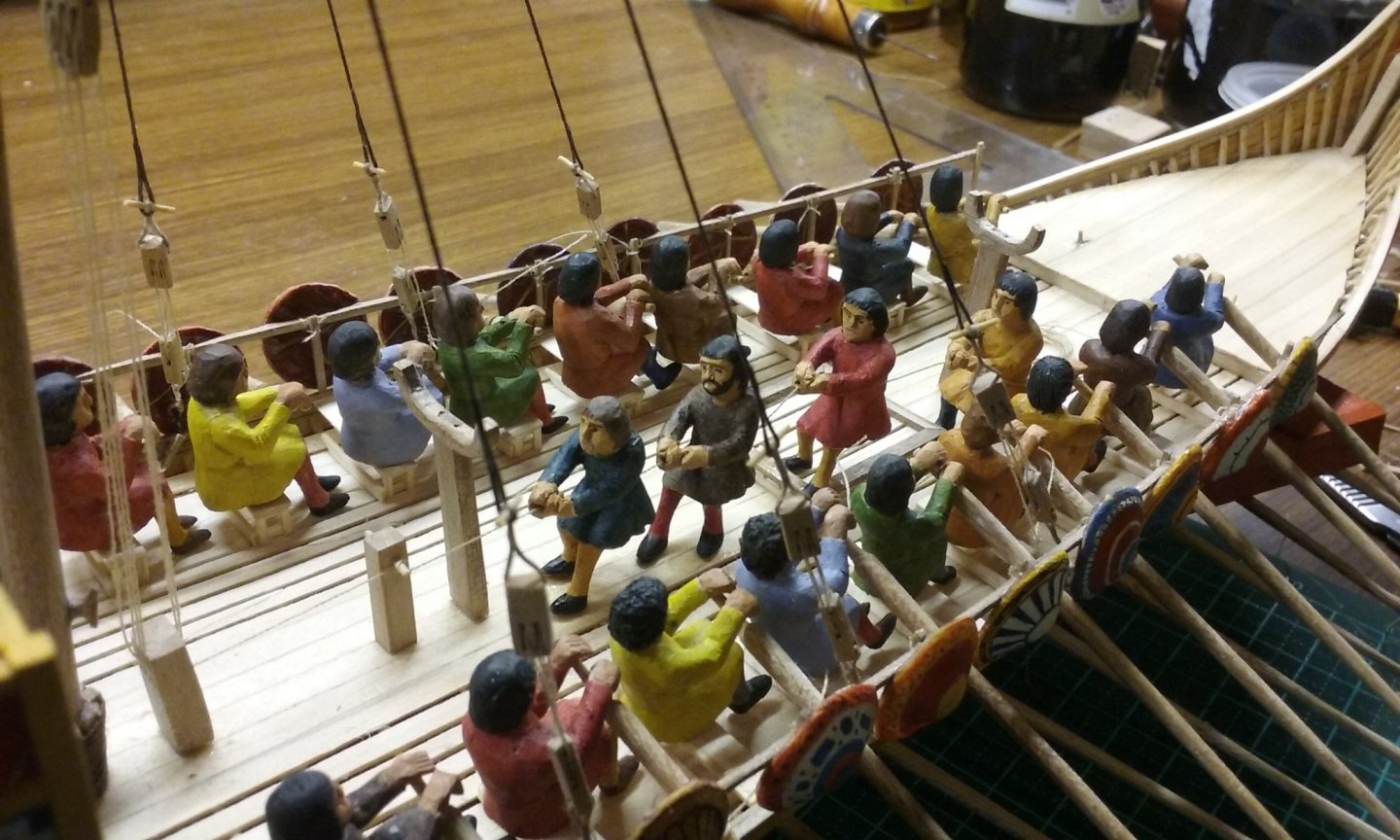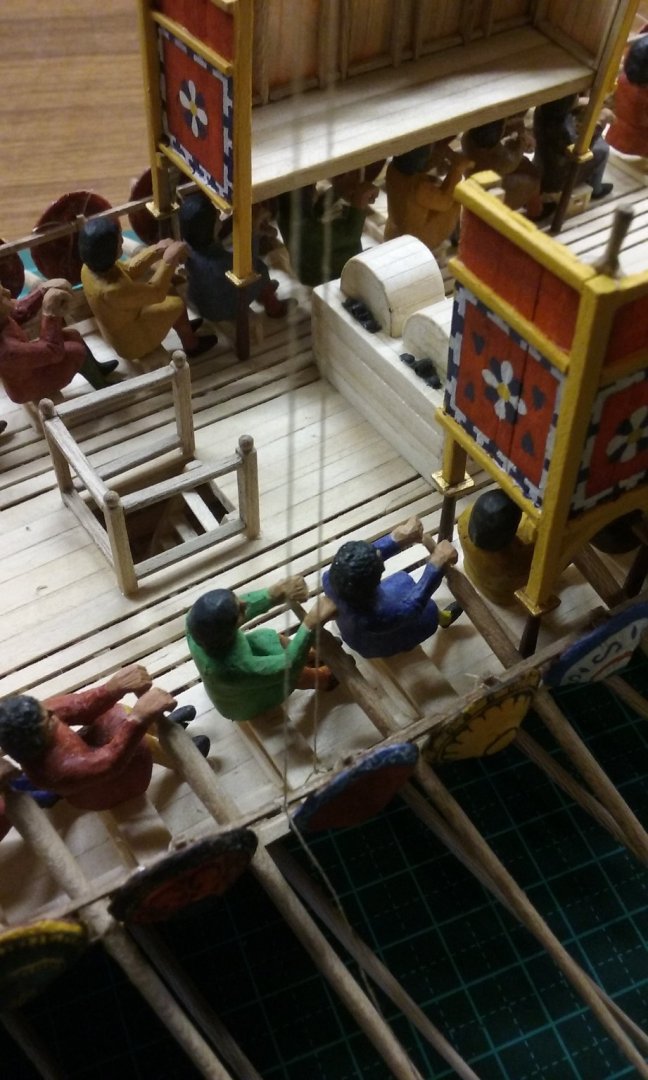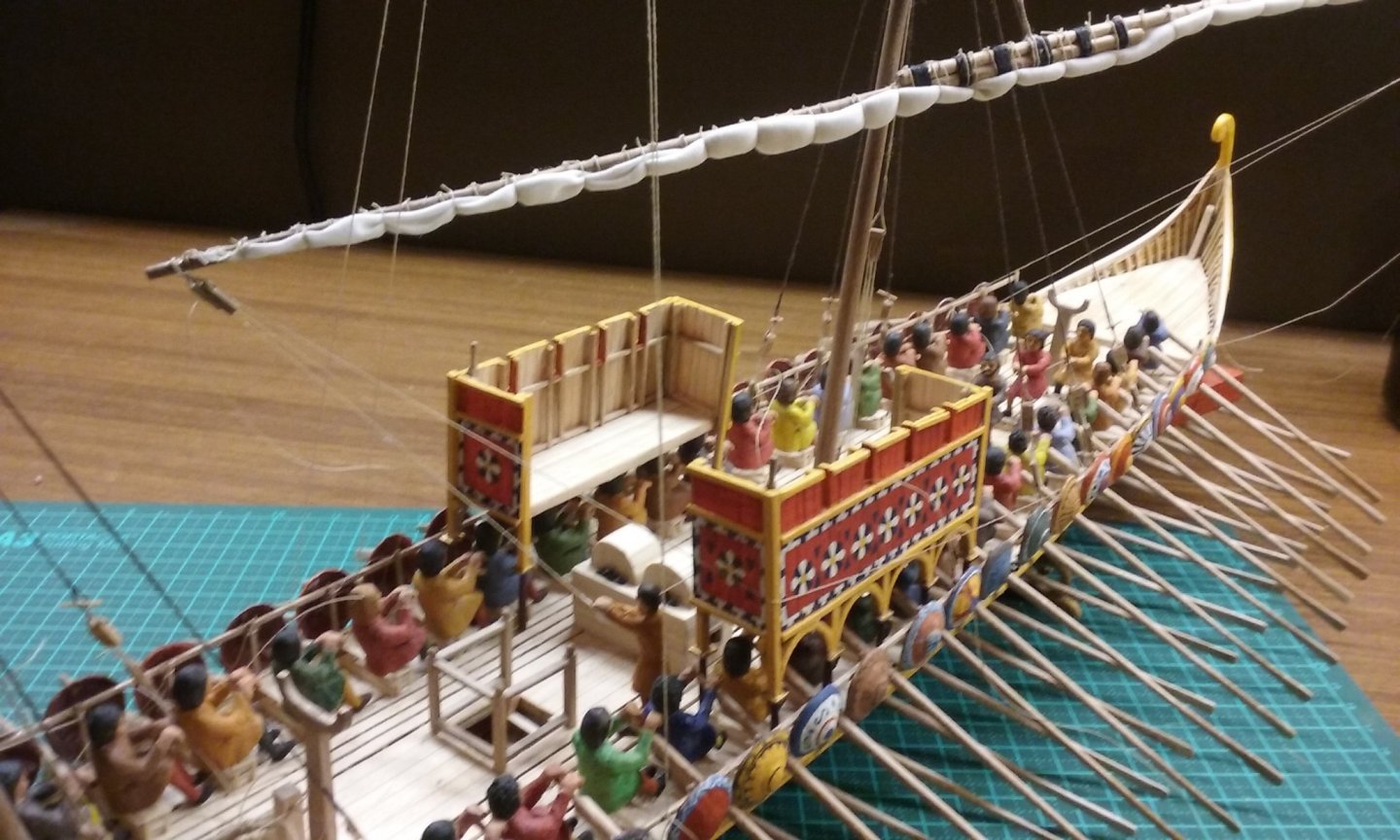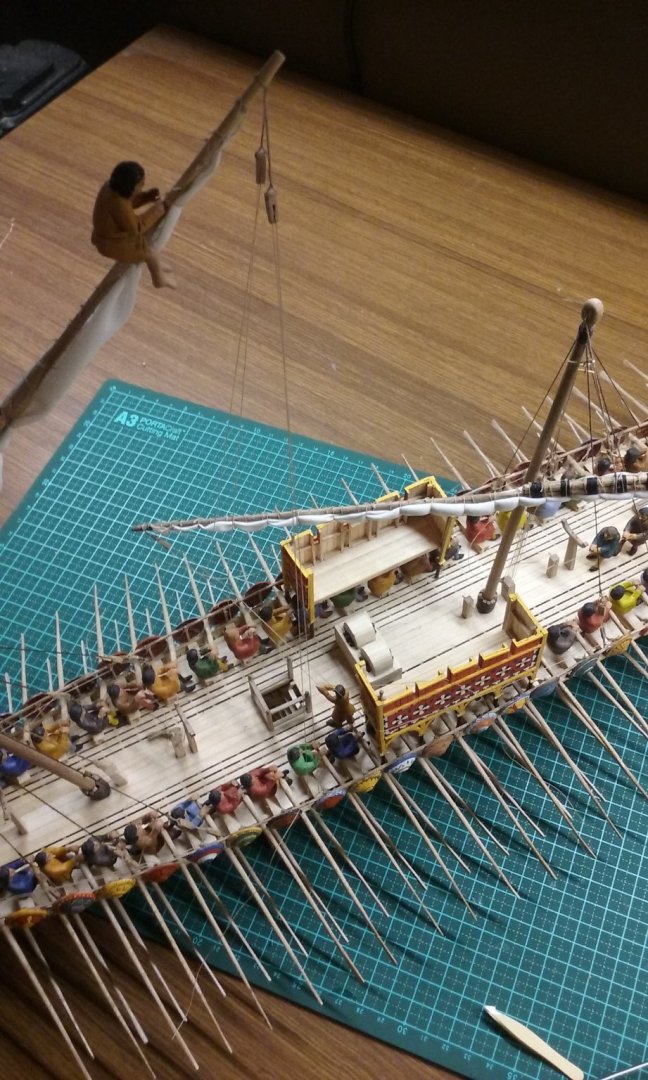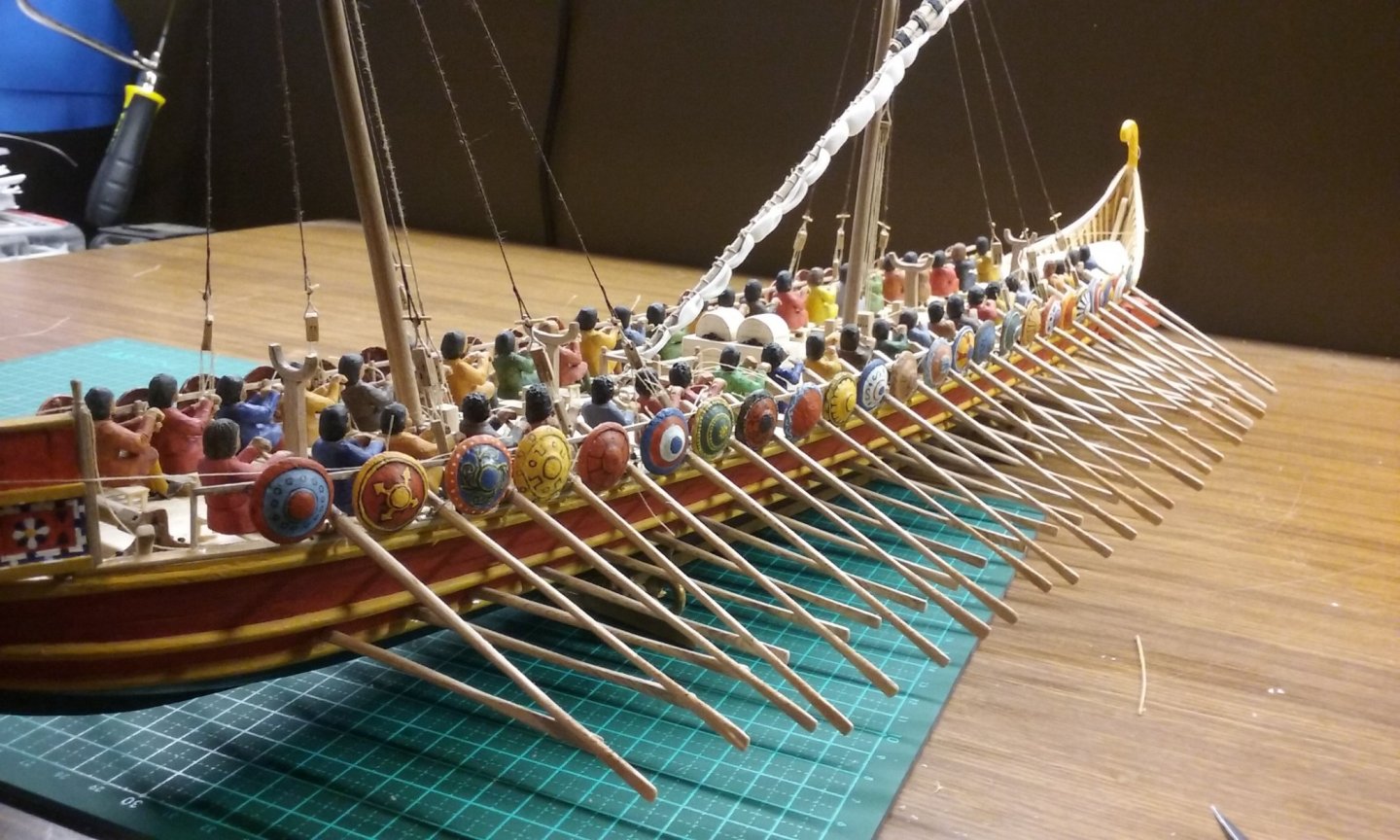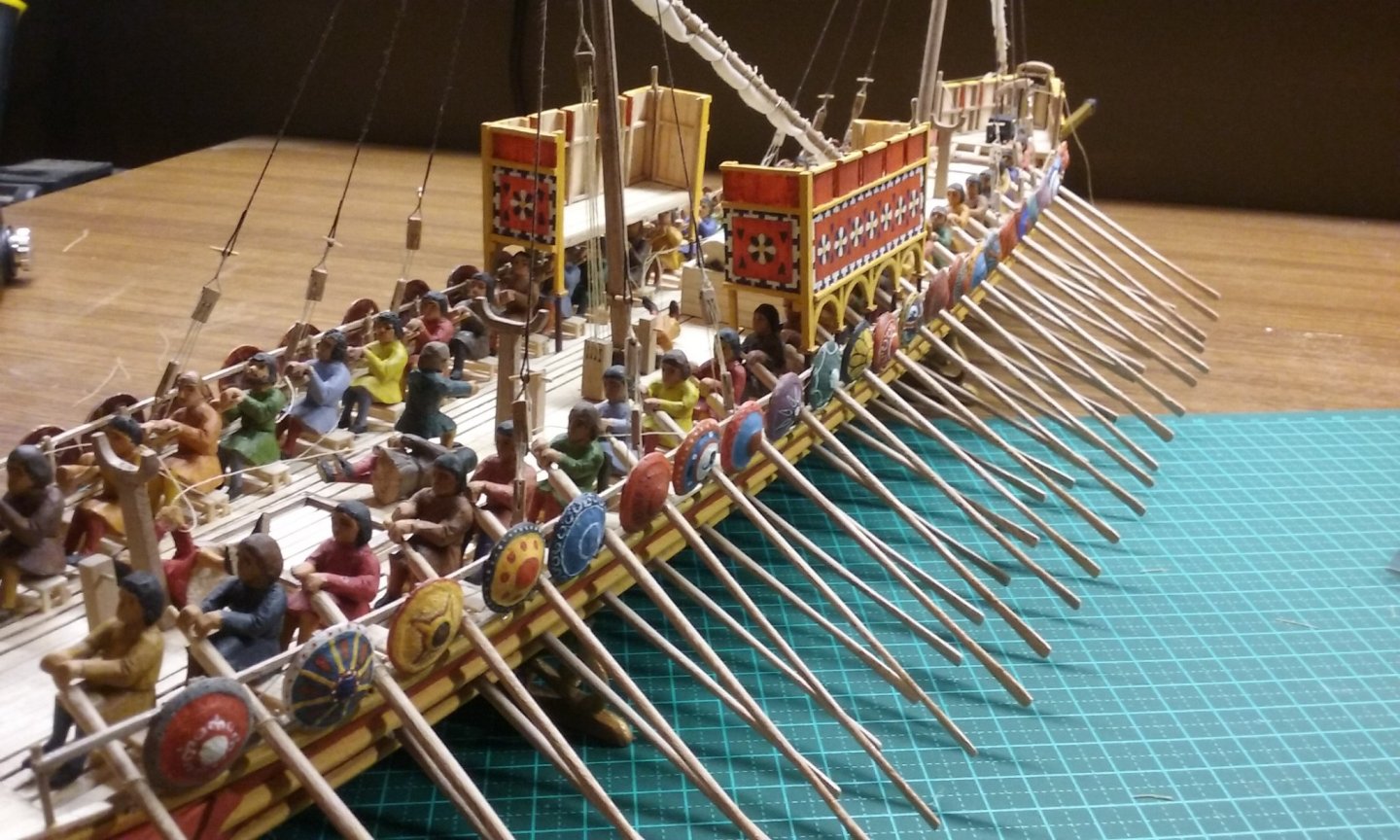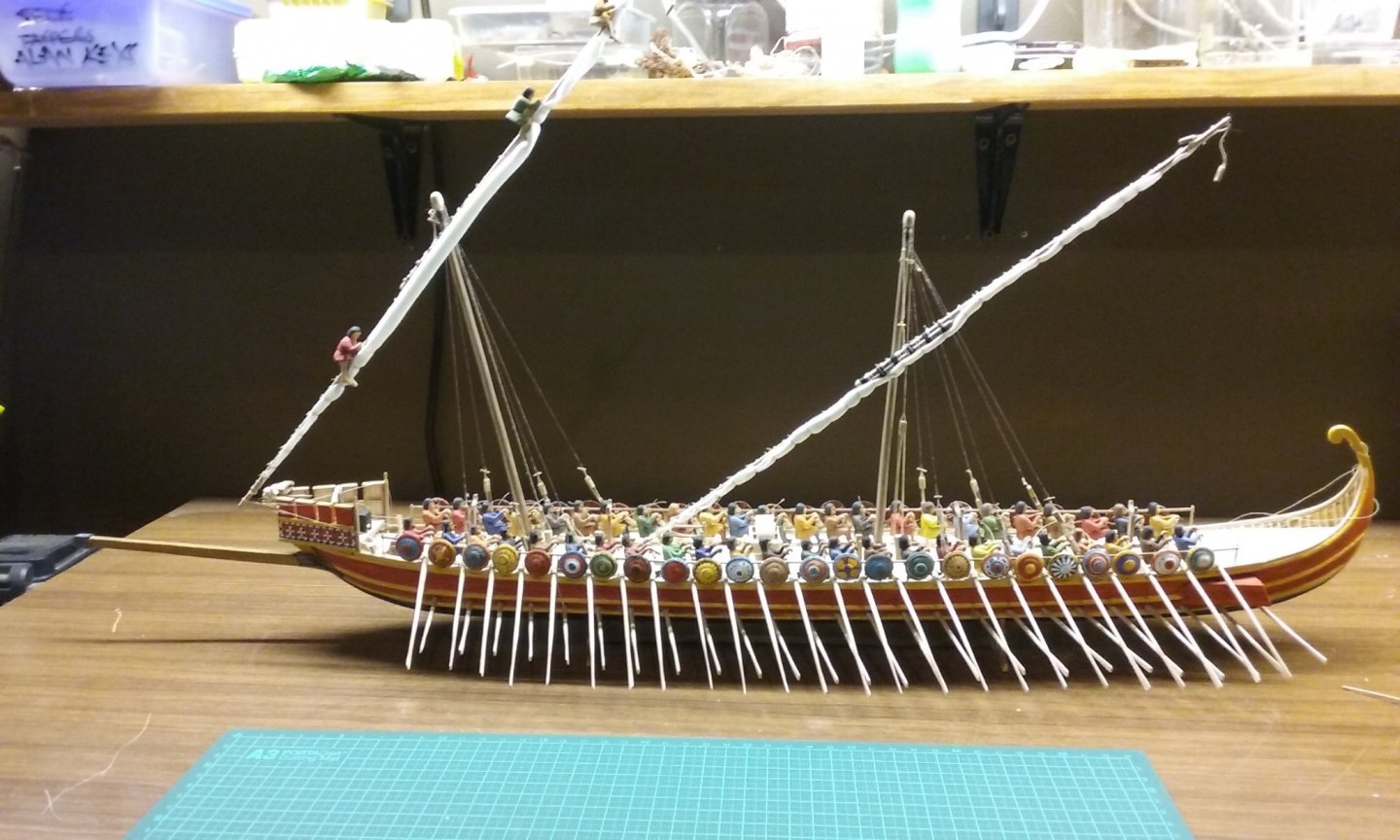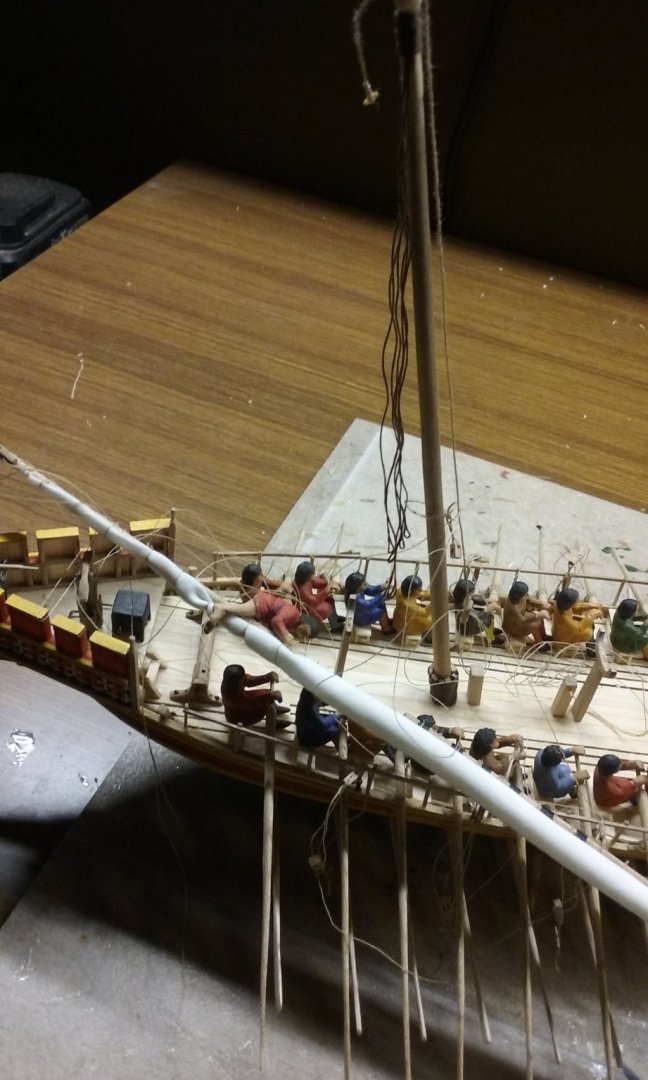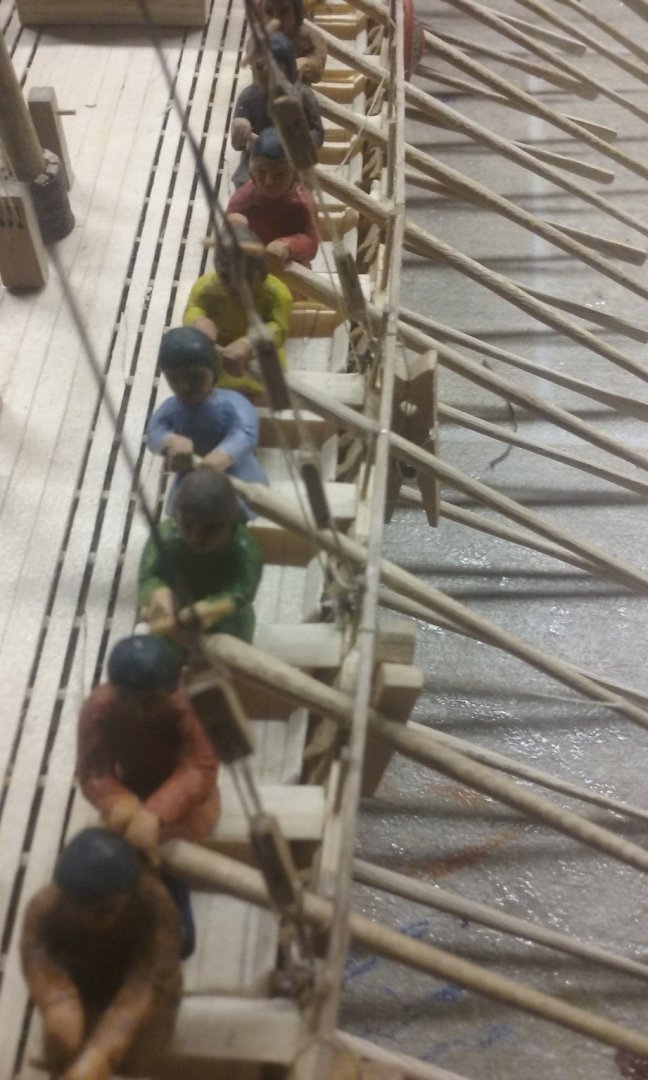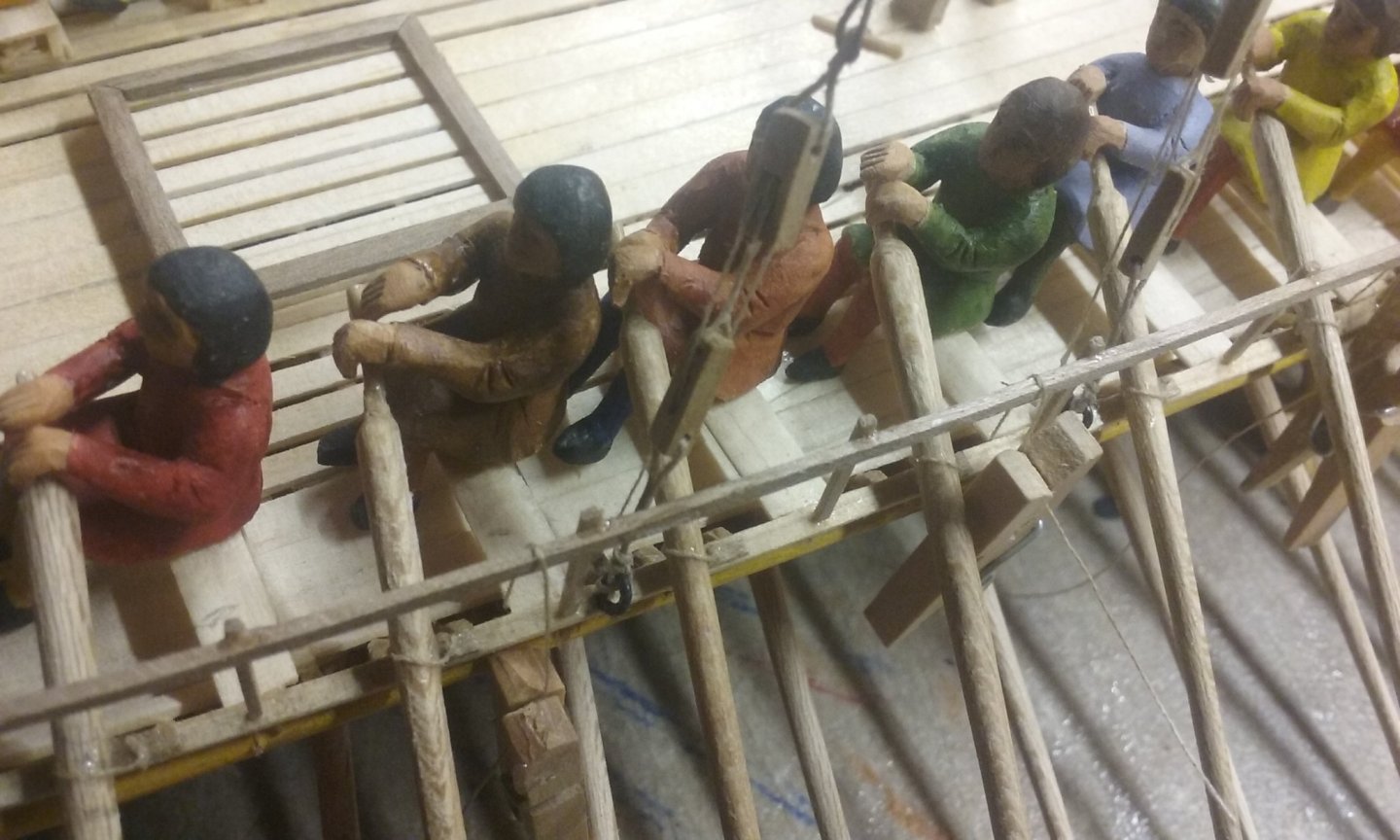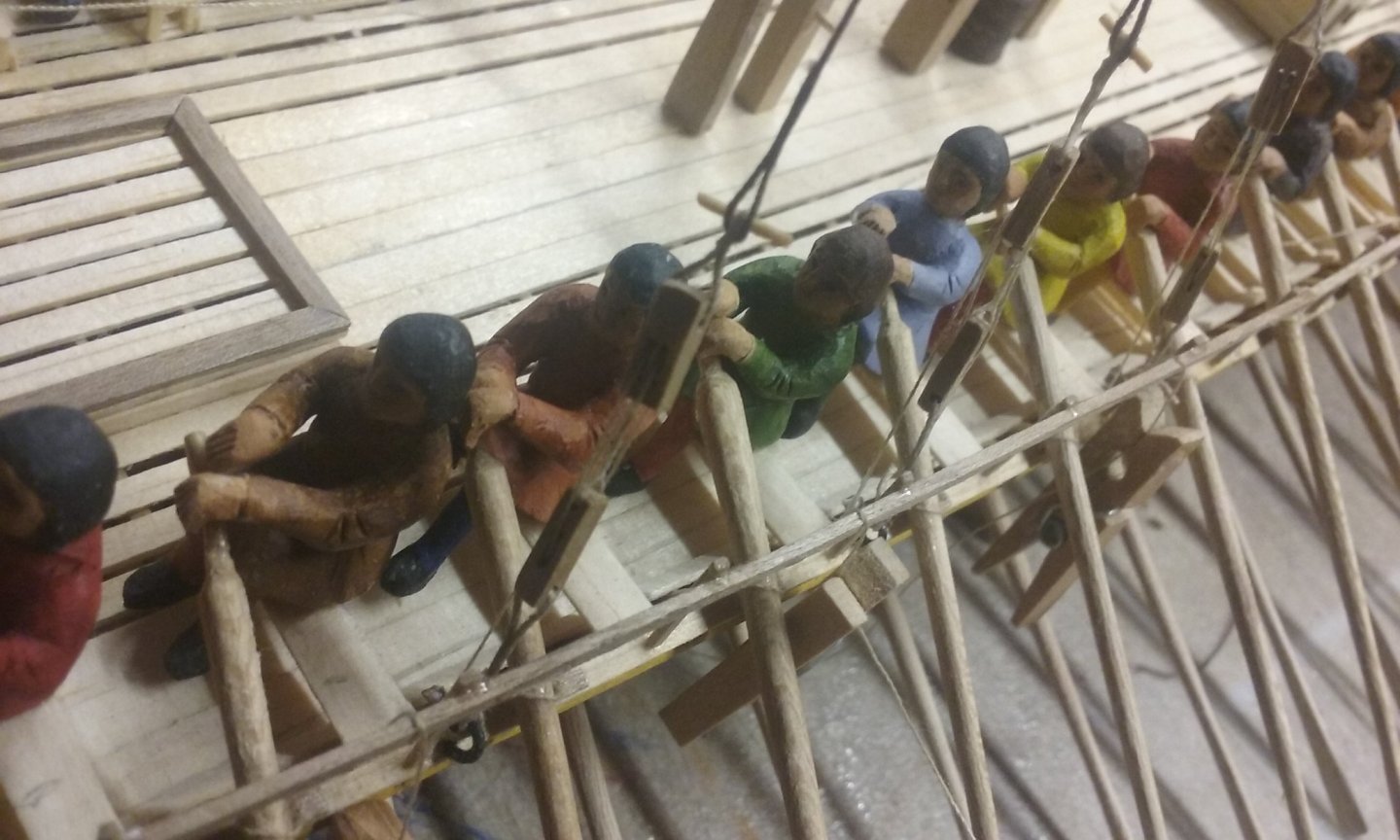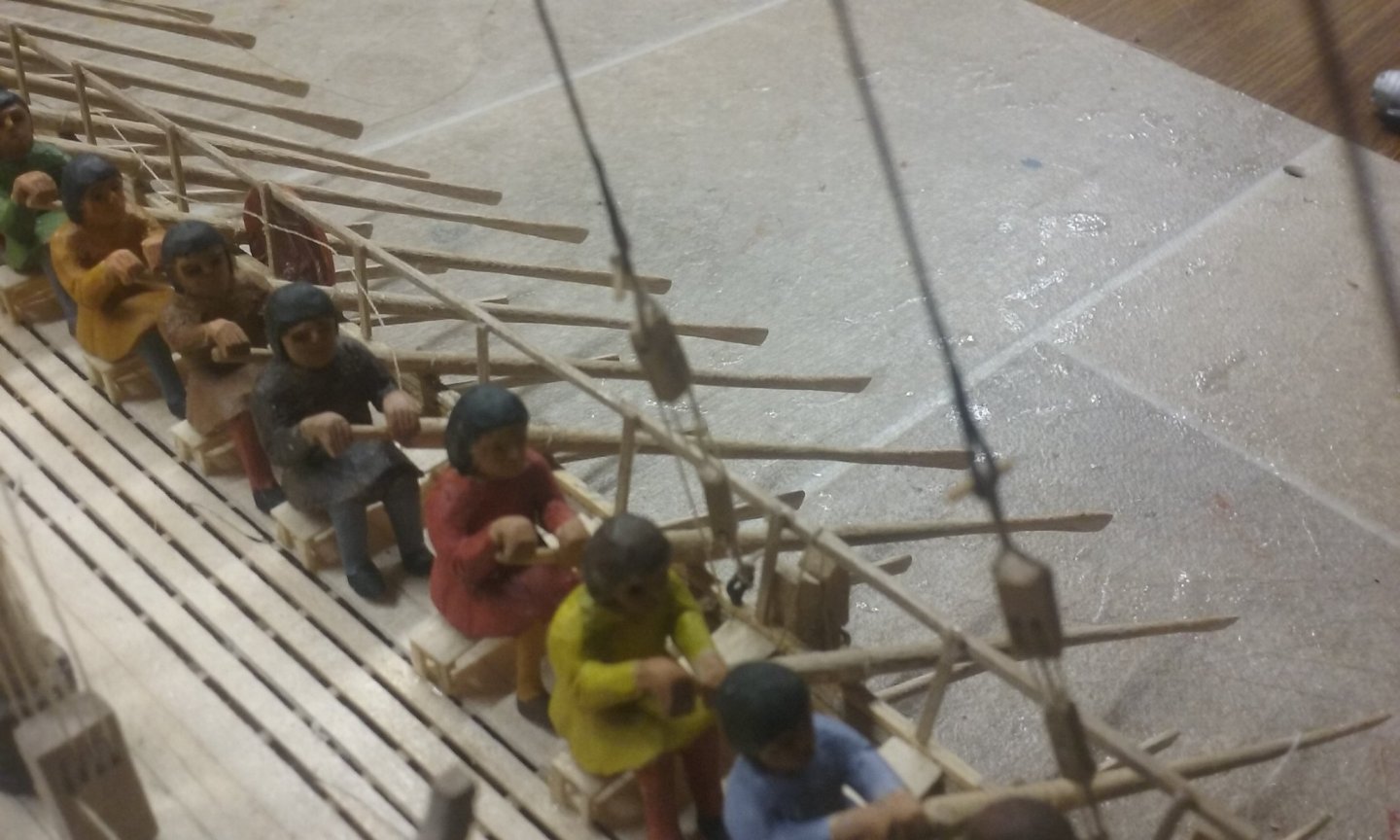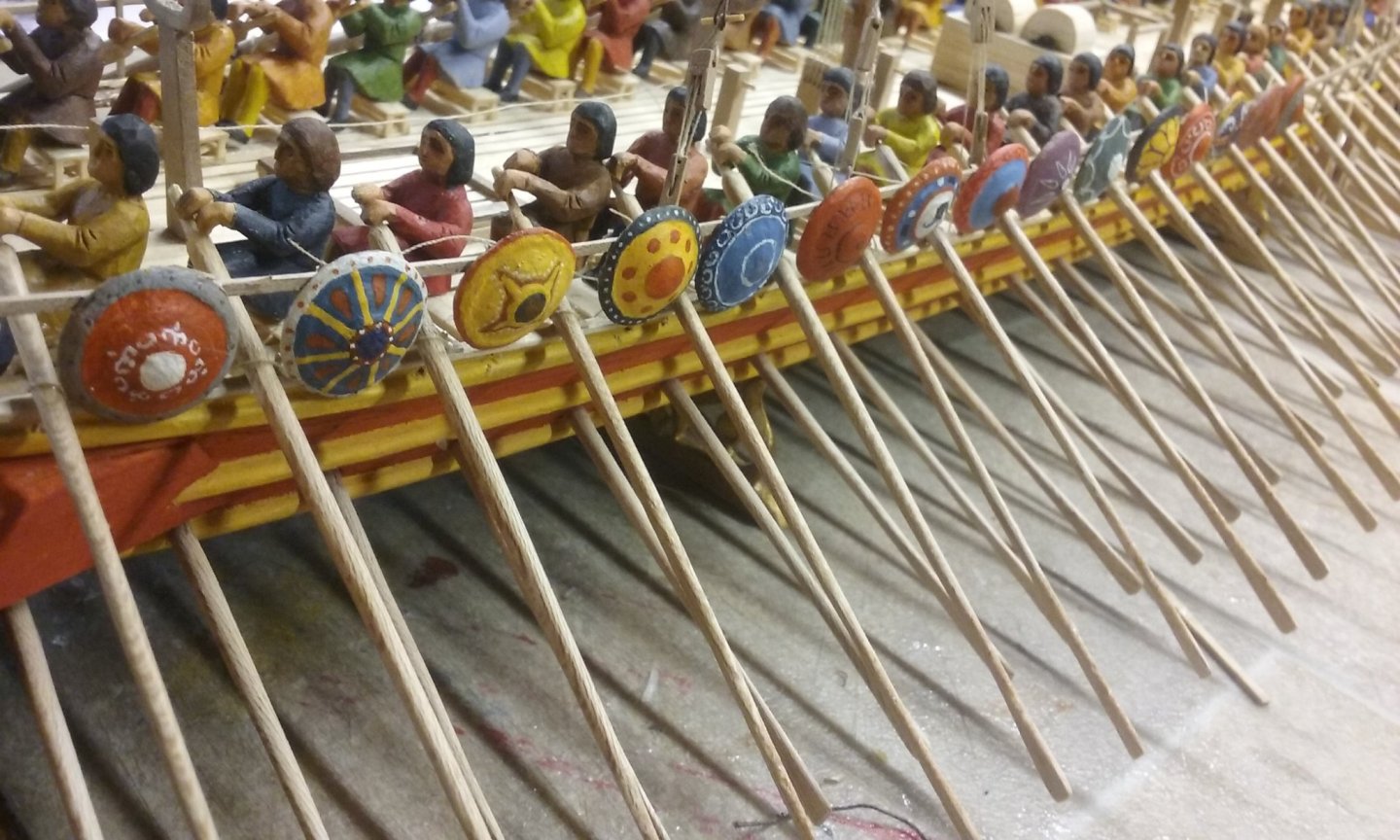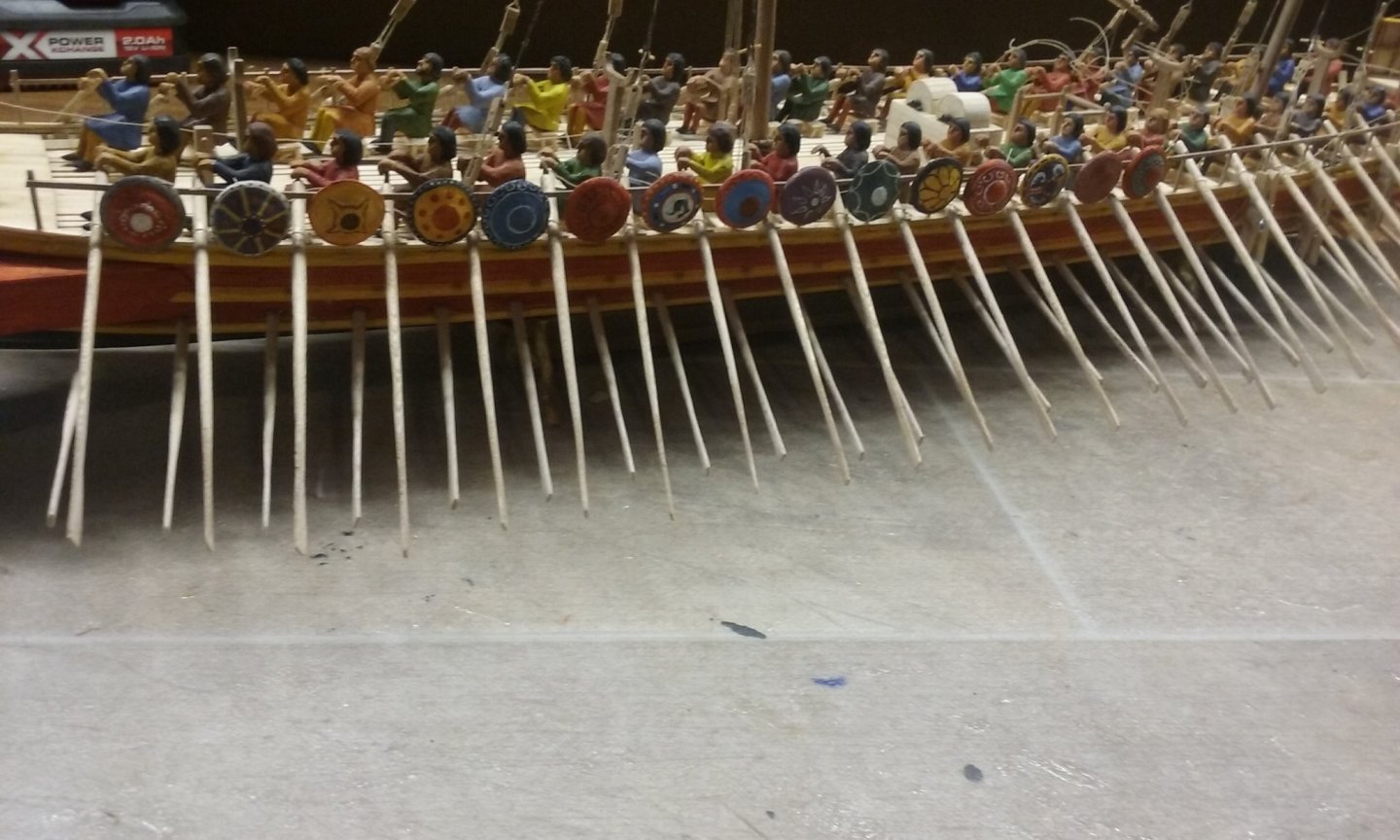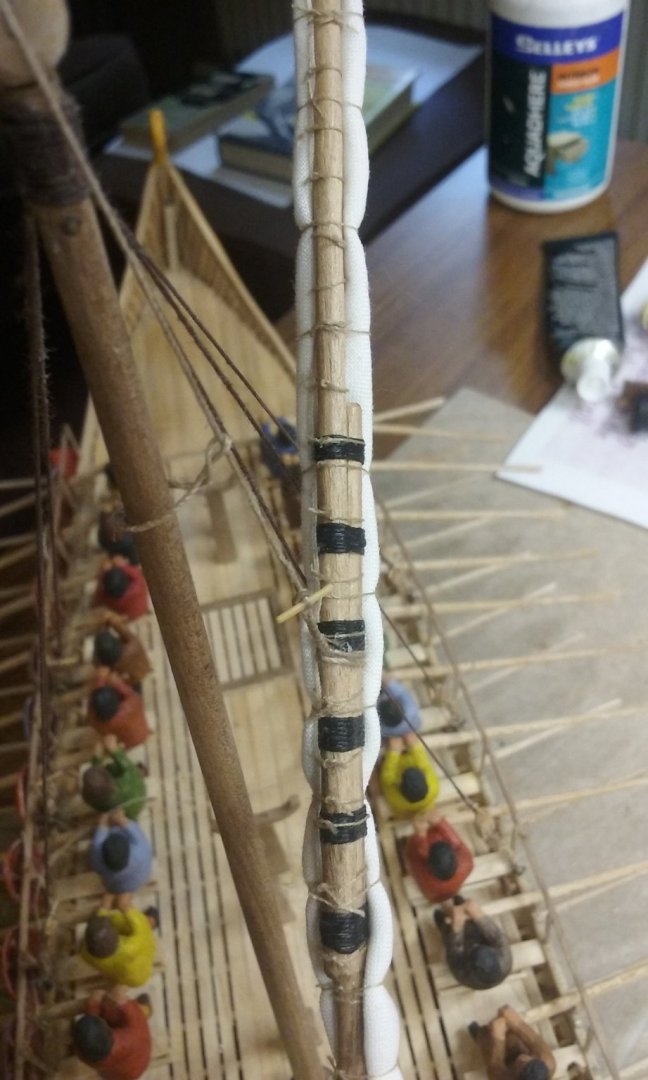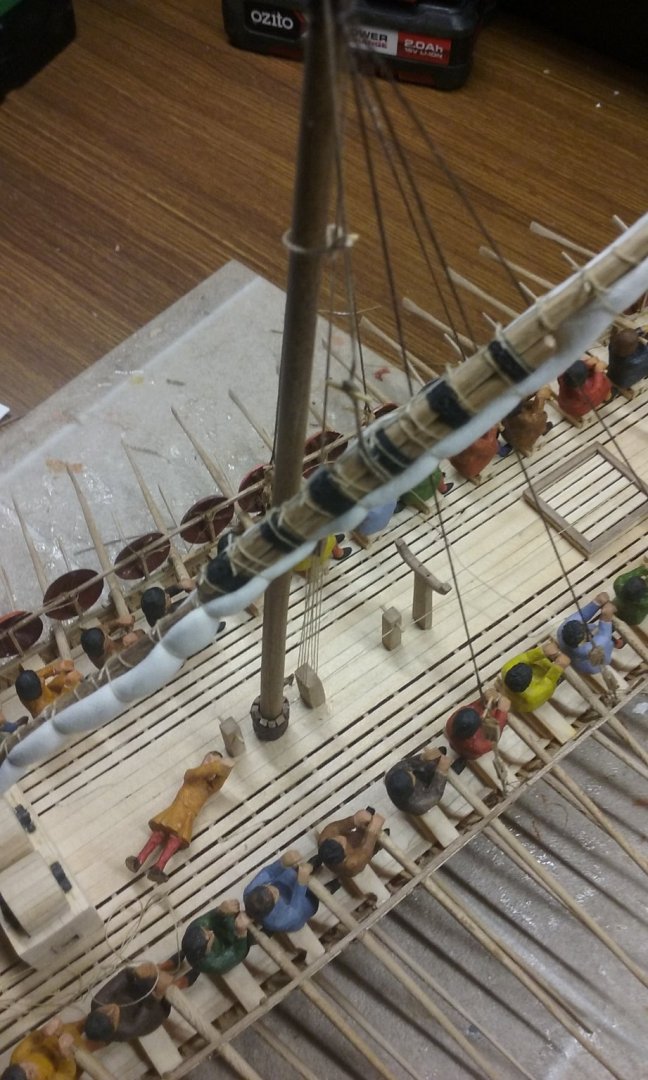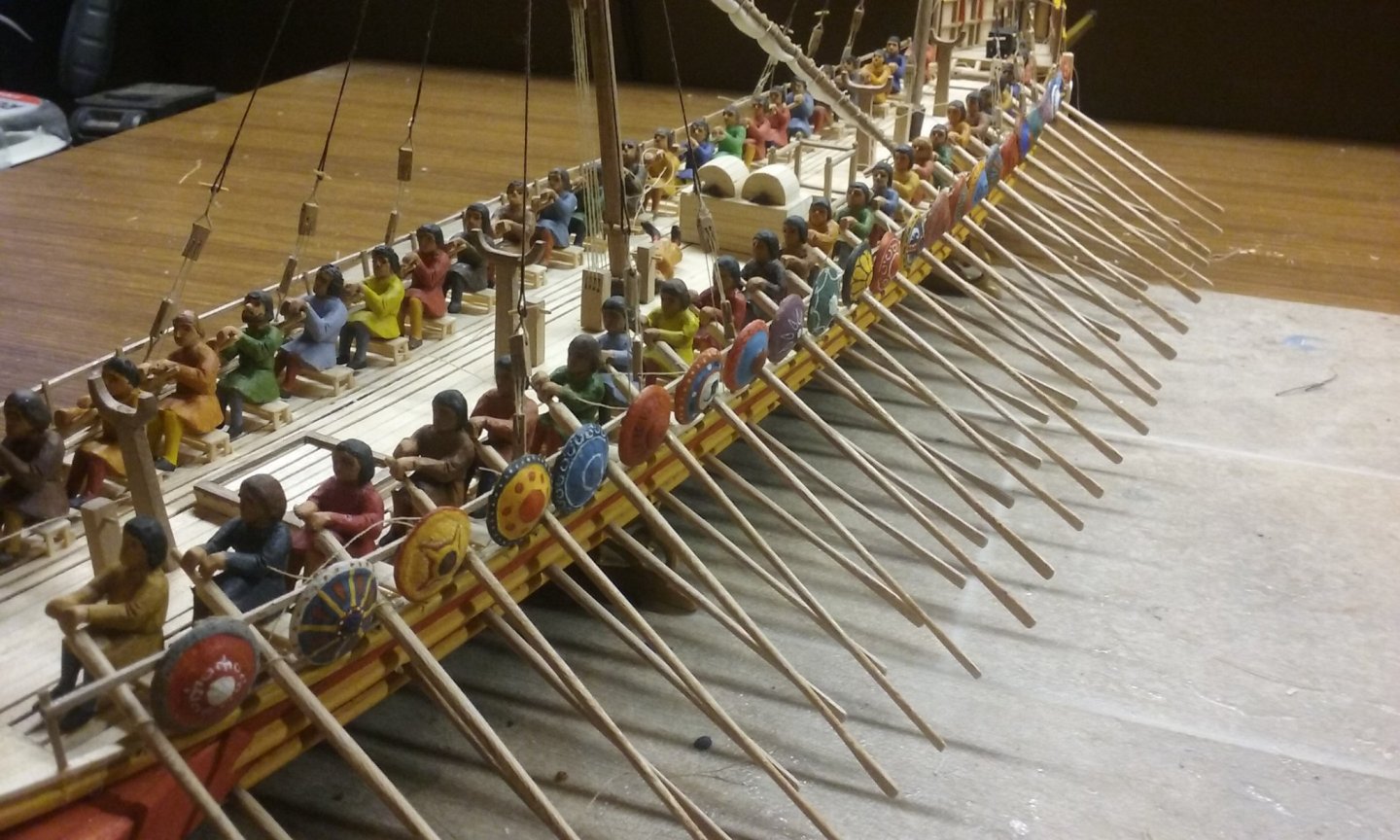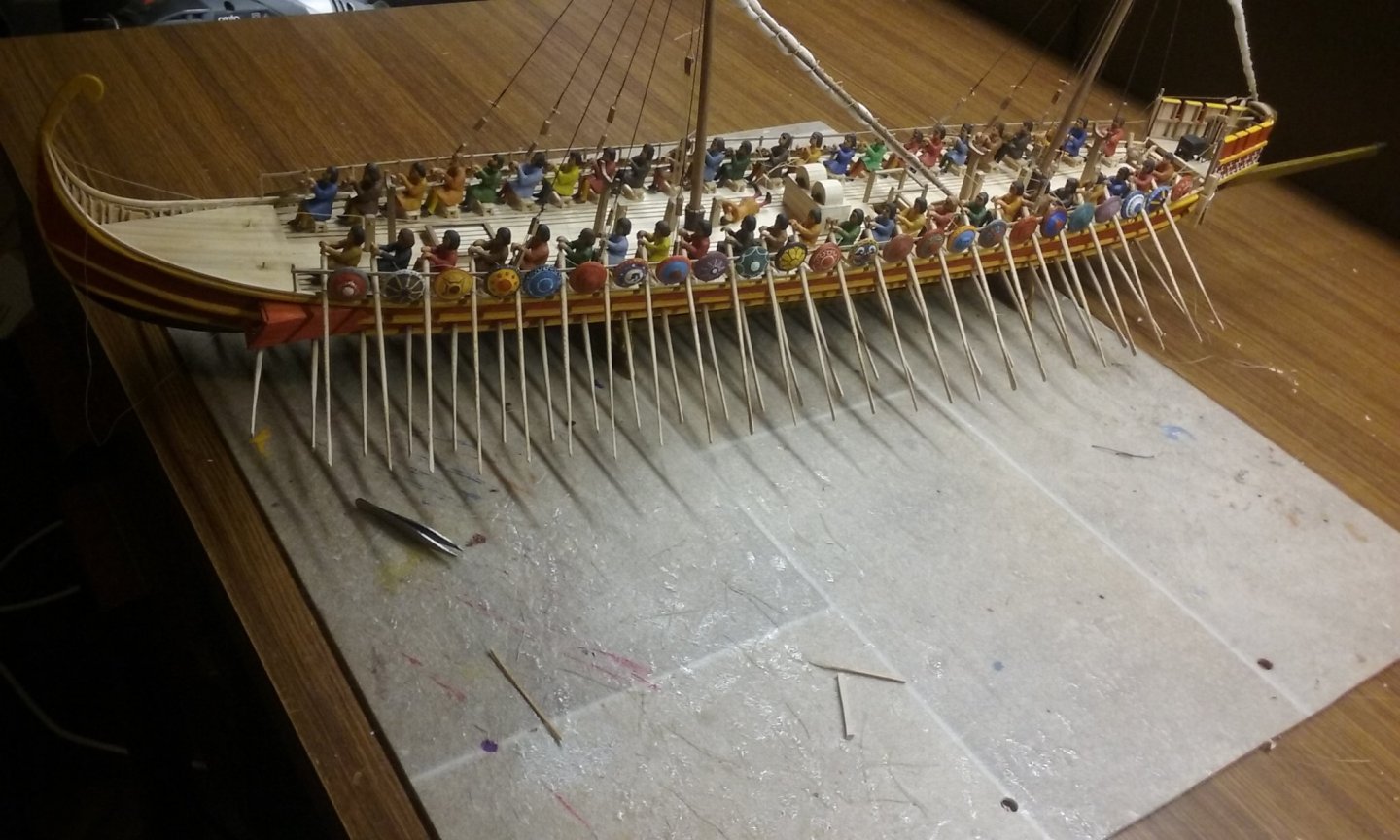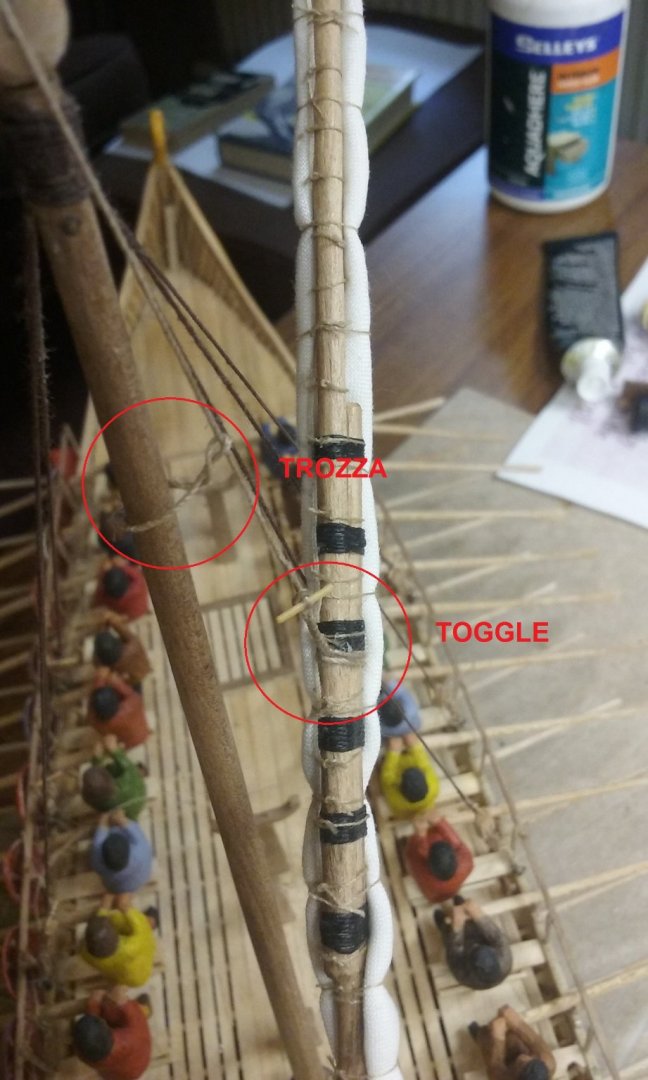-
Posts
7,987 -
Joined
-
Last visited
Content Type
Profiles
Forums
Gallery
Events
Everything posted by Louie da fly
-
I've been having a few problems with the rigging - particularly with belaying points, but I'm making slow but steady progress. My original idea for the foretacks was to run each one to a turn around a "bollard" on the forecastle which acted as a fairlead, to a point aft of the mast so the yard could be pulled back behind the mast when tacking. Only problem was - it wouldn't have worked (which I realised when I was in bed, where all one's best ideas arrive - usually at some ungodly hour of the morning). I had run the tack under the benches would have made it impossible to pull the yard back. So I re-ran the tacks, still with a turn around the "bollard", but then outside the shrouds. (The clothes-peg is just holding the rope in place while the glue dries on the bollard.) Fixed the "bitter end" around an upright of the pavesade aft of the mast, and tied off the free end to the pavesade rail nearby. Then the vangs. One end of the port vang is fixed around an oarbench, the other to the rail of the pavesade. The starboard vang is still loose: And both fore-vangs tied off: Now for the after yard. I added the crewmen hauling up the yard: Unfortunately the rope they're all holding just couldn't be a straight line due to the one of the guys standing on the hatch cover. In the real world they would have adjusted their grip to allow for that. Not so easy with carved figures . . . However, it's a small issue and I'm not going to bother about it. I know about it, and now you do as well - but I doubt anyone else will ever notice . . . Here all the ropes for the yard are loose - bosun very unhappy. So I put the fellow in yellow to work, holding the port tack so the yard doesn't swing around as it's raised. Sorry about the picture quality. The other tack will be loose, as will the vangs, as the yard is in the process of being raised. Now I'm trying to work out how to produce a natural catenary curve in the loose ropes. Cotton thread is "springy" and doesn't naturally fall into such a curve. I'm experimenting with wetting the thread and with soaking it with a weak solution of PVA (white) glue. But if anyone can make suggestions or has been in the same position I'd be grateful for advice.
-

Problems with a medieval bipod mast
Louie da fly replied to Brinkman's topic in Masting, rigging and sails
Yes, sheer legs. But regarding the fixing of the yard - perhaps a vertical "topmast" above the bipod? Then the parrel could swivel without hindrance. Otherwise it might be possible to have some kind of adjustable truss which could be loosened every time you tacked - somewhat like this one marked trozza (used on a lateen sail), but allowing for the bipod? Might be completely impractical, but it's a thought. The other thing would be to look at how the yard was held on Egyptian ships, if it's known. Unfortunately Sceatha's magnificent Byblos ship has the mast lowered and no yard fitted, or you might be able to get some ideas from his. However, on page 1 of his log there's a picture of a ship with the yard fitted, and it seems to be perched on the very top of the bipod, where the legs come together. -
That's a much more interesting name than the English one - just boring "mast cap". The Italians, on the other hand, call it a testa di moro - "Moor's head". But we make up for it with deadeyes - because they look a bit like a skull. The French call them caps de mouton - sheep's caps (unless it's an old name incorporating the Latin capitum - "head". Somehow sheep's head sounds more poetic.
- 756 replies
-
- galleon
- golden hind
-
(and 2 more)
Tagged with:
-
Thanks for the info.I use white glue as well, and I've just tried the water on q-tip method. Seems to work well. That's beautiful clean work, by the way.
- 72 replies
-
- fishing boat
- Barco Catalan
-
(and 1 more)
Tagged with:
-
Very nice. Looking forward to seeing he rigging in place. But should you also be looking at having mediaeval pyrate figures (such as Eustace the Monk ( https://en.wikipedia.org/wiki/Eustace_the_Monk ) or Roger de Flor ( https://en.wikipedia.org/wiki/Roger_de_Flor ) rather than 18th century? Or am I being too picky?
-
All the shields of the port side are in place. Check the sixteenth and seventeenth rowers, Boxbuilds! And I've finally glued the xylokastra (wooden castles) into position.
-
Thanks everybody for the likes. Me too . (Plus a chance to show off my heraldic knowledge . . .) More a labour of having painted myself into a corner . . . once I'd carved the figures to go on the poop I was committed to having oarsmen. Then when I discovered I couldn't cast them in resin within any sort of reasonable budget - and knowing I had a lot of free pear wood - I was committed. There were certainly times when I regretted ever starting on them . . . However, I actually do enjoy carving - I just wasn't expecting to have to do so much of it . . . Ha, ha. Funny man . . . Should I mention that there are no port side shields in the photo, or would that spoil the joke?
-
Making slow but steady progress. Seems to be going well so far, and you're overcoming obstacles as you come to them. What kind of glue are you using?
- 33 replies
-
Depending on who and what you were. Certainly below decks was pretty dark. The Texas A&M University, which is a centre of excellence in maritime archaeology, publishes Masters' theses by its students ( https://nautarch.tamu.edu/academic/alum.htm )one of which was all about the history of lighting on board ship (an environment very prone to fire), called Shipboard Lighting: A.D. 400-1900. Of course eyes do adjust to low light levels, but there is a limit to how much. Interestingly, the mediaeval craft guilds had a rule that nobody was to work after dark - artificial (candle) light was just not sufficient for quality work. If you want to see what it's like in a candle-lit environment (unless you go to an intimate restaurant or are a mediaeval re-enactor) see if you can get a look at interior clips from the movie Barry Lyndon, which was filmed only by candle-light because the director (the great Stanley Kubrik) decided it was the only way to convey the true atmosphere of the time. They had to develop special cameras to do so, and as far as I'm aware it's the only movie where it was ever done.
-
That's a very good result, Hellmuht. This is a very enjoyable log to follow. (I'm learning a lot)
- 158 replies
-
- byblos ship
- Egyptian
-
(and 1 more)
Tagged with:
-
That's very nice work, Lapinas. I'm looking forward to the next instalment of this saga . . .
- 93 replies
-
- santa maria
- amati
-
(and 1 more)
Tagged with:
-
Hi Mark and welcome. Is this a kit or a scratch build? Either way, it looks very good. Make sure you start a build log - that way you'll get a lot of encouragement, plus help and advice (if needed - though it looks like you may not need it! )
-
Beautiful work. What are you using for cleanup? Just water?
- 72 replies
-
- fishing boat
- Barco Catalan
-
(and 1 more)
Tagged with:
-
And Australia, for that matter. And all the rest of the Commonwealth, except England itself. But honestly, only Scotland makes it official. It's to do with national pride and individual identity, and at least partly to do with an attitude which resulted in books of British history until recently being entitled "A history of England". The first monarch of England and Scotland was of course James the Sixth of Scotland and James the First of England (when I was a kid I saw a picture in a book with that title, and couldn't work out why there was only one person in it - true story)
-
PhilB that's a whole subject in itself, which others know a lot more about than I do. Apparently there were tables for how thick a rope should be for a particular job - obviously the mainstay had to be thicker than the mizzen stay because the load was greater. You might try a search for rope thickness or size, or something of the sort in the Search function at the top of the MSW page. Or else look through the "Masting Rigging and Sails" section. Or if all else fails, put an info request up in the same section. Then you'd need to convert rope size (which is measured as the circumference, not the diameter) to thread weight at the scale you're working in. But that was for the Great Days of sail - the 18th and 19th centuries. There are naturally no tables from the Middle Ages. For my build I got quite a few thicknesses of thread and just chose a thickness that looked "right" for the job it had to do, and I suggest you do the same. Aaah, you're thinking of Western Europe, where the so-called "coat of arms" was on the shield, on the clothes, on the horse-trapper, sometimes even on the helmet, such as in these renditions of Diepold von Schweinspeunt (Note the wild boar emblem as a pune or play on words on the name Schweinspeunt) from the Liber ad Honorem Augusti (Italy under Emperor Frederick II) c. 1195 The Byzantines didn't get involved with all that sissy stuff . . .
-
You've done a beautiful job, Rik. That's a model to be proud of.
- 41 replies
-
- artesania latina
- dallas
-
(and 1 more)
Tagged with:
-

Greetings! Long time lurker coming out of the bushes!
Louie da fly replied to EKE's topic in New member Introductions
Hi Erik,and welcome to MSW. That's a nice model you've chosen. You've done the right thing starting a build log. Remember to ask questions if you hit problems. If I recall correctly there are quite a few build logs of this model on MSW - looking at them can also be very helpful. -
Dark rope is "tarred" - standing rigging was often coated with tar to preserve it. Running rigging couldn't be, because it had to run through blocks etc - tar would make the rope stiff, and also build up on the things it rubbed against (like the blocks).
-
Well as I mentioned before, I've re-jigged the blocks at the bottom of the shrouds. Naturally enough, since I was shortening the block assembly, the shrouds needed to be longer so I had to replace them. I was lucky enough that one shroud in each set could be re-used, and that I seemed to have enough dyed cord to make the rest. Until the last moment, when I discovered I was one shroud short! The existing shrouds are darkened to look like tarred cordage. I dyed another lot of cord, having to re-insert it into the dye bath three times to get the colour to match . Of course as soon as I'd finished, I discovered I actually had just enough of the old cord to do all the shrouds after all. Ah, well, at least I've got some nice dark cord that I can use for other things. Here is the ship with shrouds undone and incidentally the yards lowered to allow new shrouds to be installed. The bosun is going to be in big trouble from the captain for that horrible raffle on deck. Here is the new, shorter, block arrangement. (Sorry about the vagueness of the photos - I don't know what went wrong the day I took them). I'd originally put cleats inside the hull walls to belay the downhauls - I'd used modern cleats because none have been found in archaeology but I really wasn't happy with them. Then when it came to it I found it was much easier and probably more sensible to belay them to the oarbenches. At least as strongly fixed as a cleat and much more convenient to use. You'll note small clothes-pegs hanging from the sides of the ship - they're holding the downhauls in tension while the glue dries. After that I removed the pegs and tied off the downhauls. That raffle of unsecured ropes is getting gradually less. The bosun will be happy. After I'd replaced the shrouds my lovely (and observant) wife, all unsuspecting, pointed out that the after yard was hoisted inside the shrouds (instead of outside where it should have been). Oops. So I had to loosen off the tacks which I'd temporarily tied up, undo the toggle that held the yard to the halyard, and take the halyard off and re-set it outside the shrouds. I'm very glad she noticed it. It would have been murder to fix it later in the build. And here is the after yard in its correct place - you can see the toggle which joins the halyard to the yard itself, as well as the trozza (truss) that holds the yard to the mast. The guy lying on the deck isn't dead. He's "in storage" - when the four guys are put in place hauling up the yard he'll be holding the tack to keep the yard under control. To provide belaying points for the ropes of the after lateen sail (tacks and vangs) I need to install the xylokastra (wooden castles). But first I have to add the shields to the pavesade - the castles would make it impossible to reach in and tie off the ropes holding the shields on. In an earlier post I showed the ochanos (straps) at the back of the shield. To hold each shield in place I tied a piece of cotton sewing thread (to resemble rope, same as I've been using for the rigging) through the ochanos and around the railing and each upright of the pavesade, then added a dab of glue to make it permanent. That holds it fairly securely, though I may also glue the bottoms of the shields in place to stop them from flapping around. Here are the shields about half-way installed on the starboard side: And here's the starboard side complete. It's nice after having painted all these shields some months ago and having had them in storage all this time, to finally be able to put them in place. I'm pretty happy with the way they look. Certainly makes the ship look more colourful.
-
Very nice. A superb build of a beautiful vessel.
- 72 replies
-
- fishing boat
- Barco Catalan
-
(and 1 more)
Tagged with:
About us
Modelshipworld - Advancing Ship Modeling through Research
SSL Secured
Your security is important for us so this Website is SSL-Secured
NRG Mailing Address
Nautical Research Guild
237 South Lincoln Street
Westmont IL, 60559-1917
Model Ship World ® and the MSW logo are Registered Trademarks, and belong to the Nautical Research Guild (United States Patent and Trademark Office: No. 6,929,264 & No. 6,929,274, registered Dec. 20, 2022)
Helpful Links
About the NRG
If you enjoy building ship models that are historically accurate as well as beautiful, then The Nautical Research Guild (NRG) is just right for you.
The Guild is a non-profit educational organization whose mission is to “Advance Ship Modeling Through Research”. We provide support to our members in their efforts to raise the quality of their model ships.
The Nautical Research Guild has published our world-renowned quarterly magazine, The Nautical Research Journal, since 1955. The pages of the Journal are full of articles by accomplished ship modelers who show you how they create those exquisite details on their models, and by maritime historians who show you the correct details to build. The Journal is available in both print and digital editions. Go to the NRG web site (www.thenrg.org) to download a complimentary digital copy of the Journal. The NRG also publishes plan sets, books and compilations of back issues of the Journal and the former Ships in Scale and Model Ship Builder magazines.


